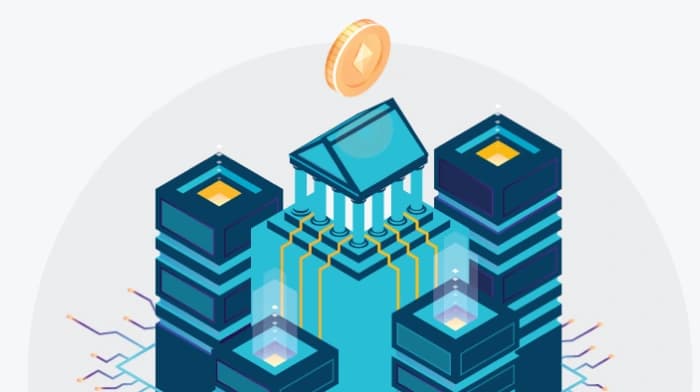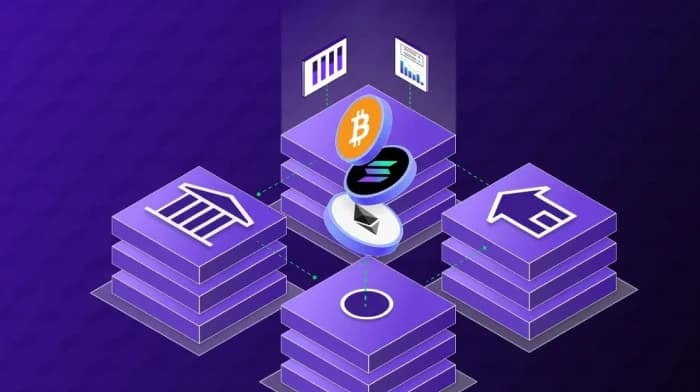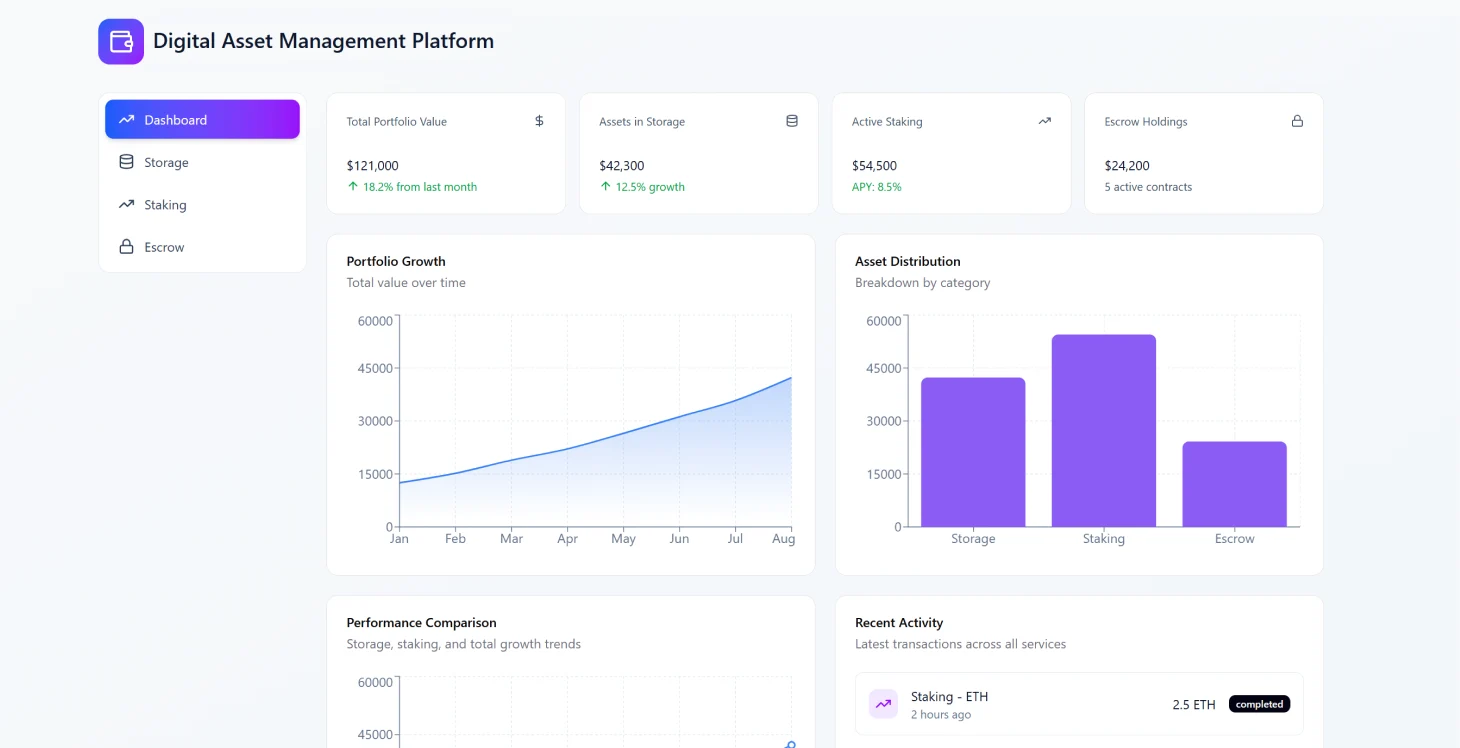
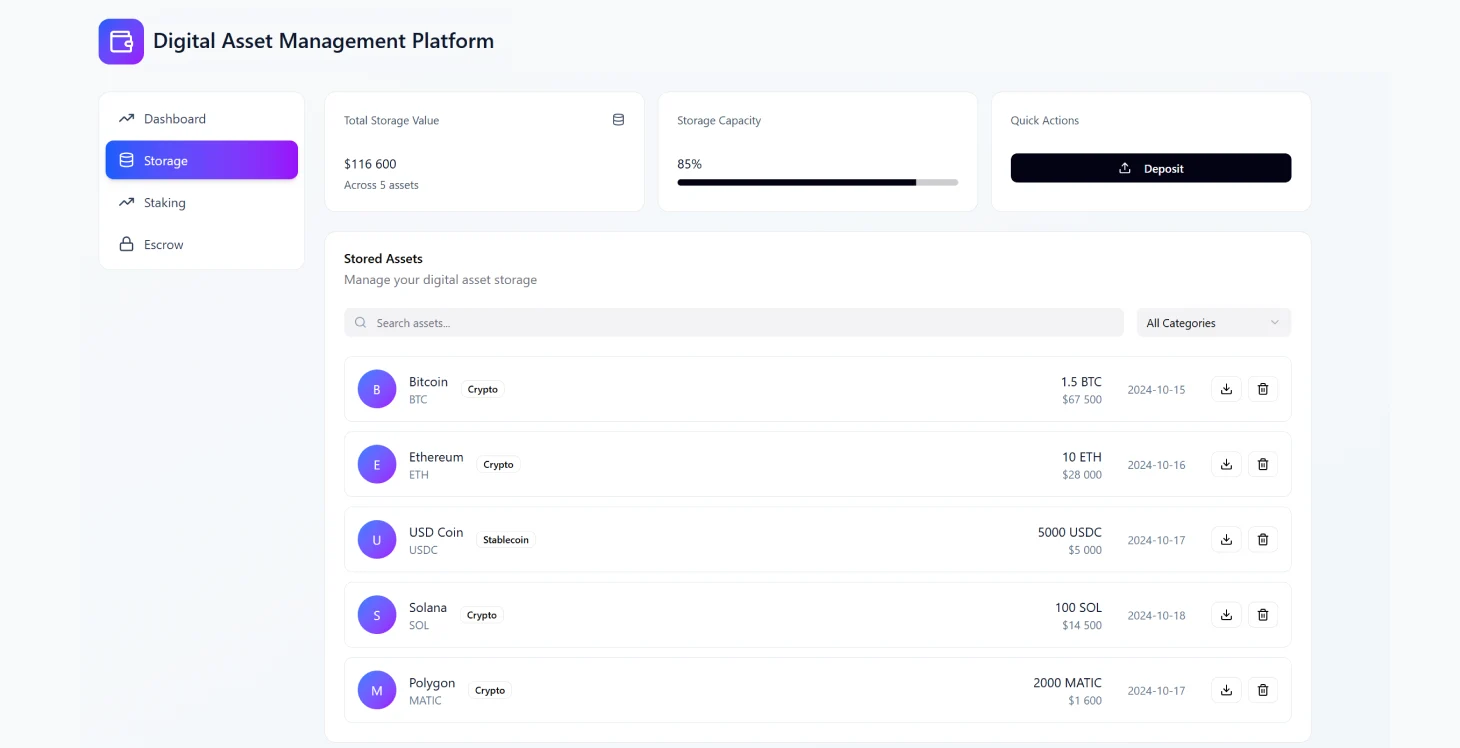
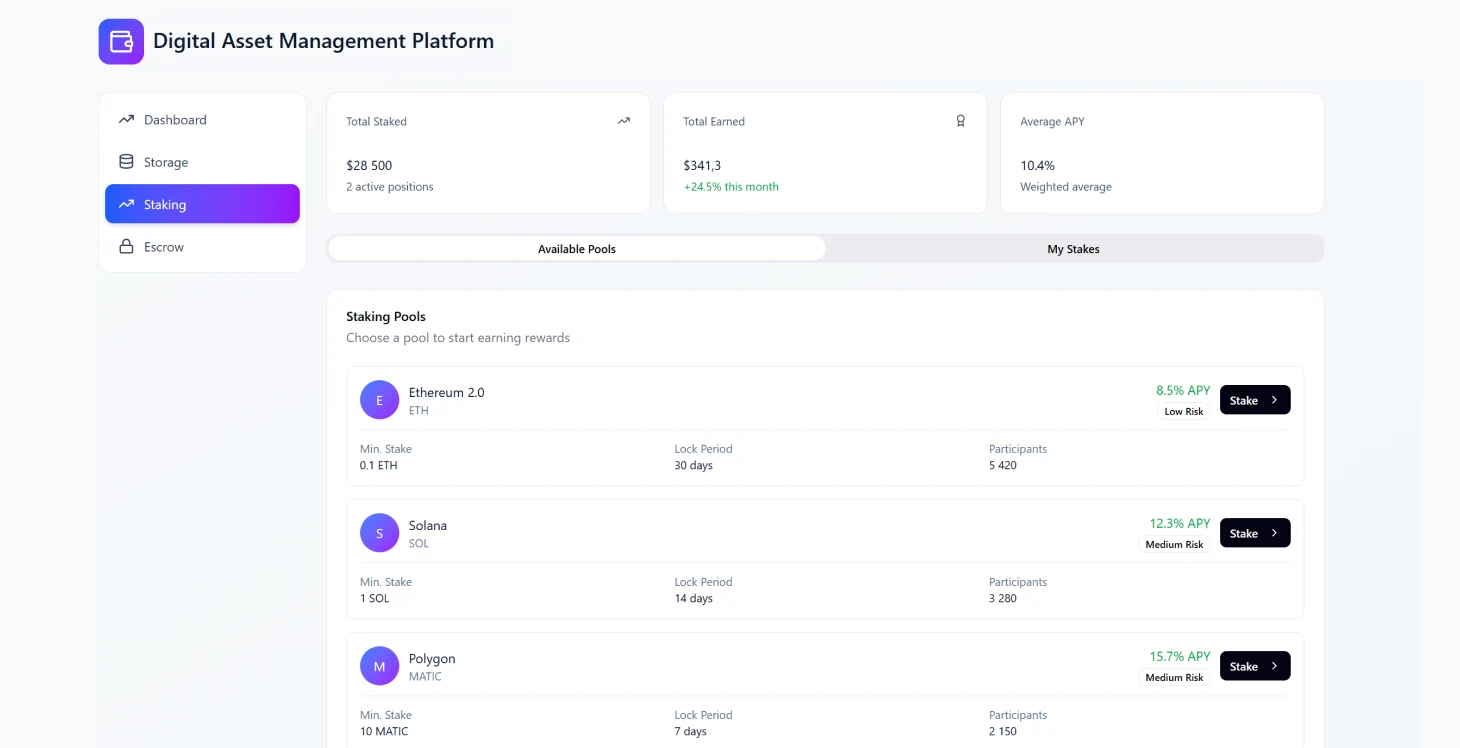
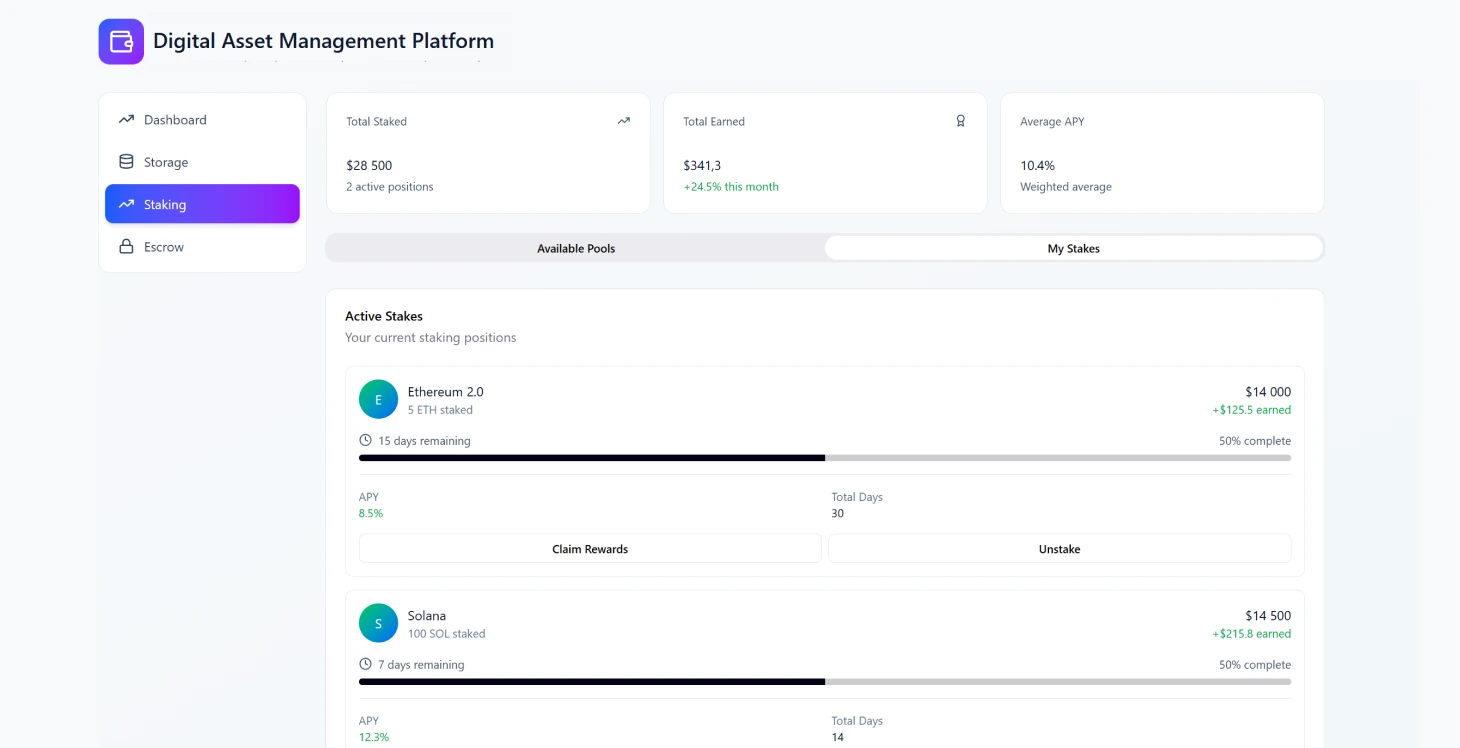
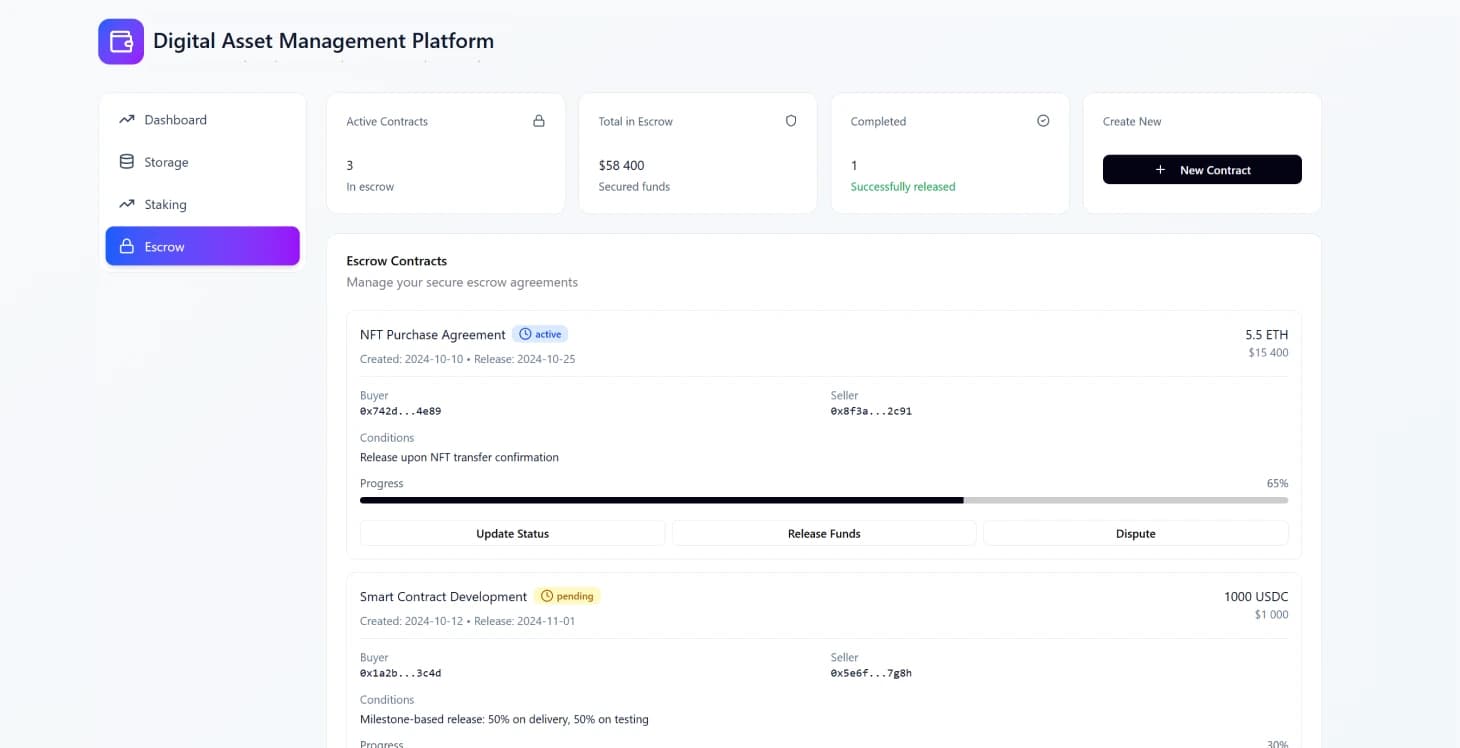
Project Overview
We developed a comprehensive digital asset management platform that revolutionized blockchain finance by consolidating storage, staking, and escrow functions into a single, enterprise-grade solution. The platform achieved remarkable results including 99% uptime, 340% user growth over 18 months, and reduced feature development cycles from 6 months to 6 weeks through community-driven development processes.
Platform Performance and Growth
The digital asset management has been brought together into one platform that handles storage, staking and escrow functions with an uptime of 99%.
The removal of obstacles in technology with the use of contracts and user-friendly interfaces led to a 340 percent rise in active users over the span of 18 months.
Implemented strategies involving community input to speed up the process of developing features reducing the time from 6 months to 6 weeks by working together on enhancing protocols.
Current State of Blockchain Finance
The world of finance has reached a turning point with blockchain technology offering groundbreaking potential yet facing challenges due to accessibility issues. Established financial institutions find it challenging to adopt distributed ledger technologies while adhering to regulations and meeting user experience expectations.
The world of blockchain faces a challenge with its nature as users must juggle platforms and protocols for simple financial tasks like transfers and transactions using smart contracts can be complex and exclude many due to the technical know-how needed while worries about managing private keys add another layer of concern for security and usability issues arise in the ecosystem.
Challenges in the sector are worsened by uncertainty since financial service providers need strong compliance systems and audit trails that some blockchain solutions don't offer sufficiently.
Primary Integration Obstacles
The primary obstacles hindering the integration of blockchain technology into finance revolve around three aspects:
Technical Complexity Barriers
Interacting with blockchain technology at a level involves grasping concepts and optimizing gas usage while implementing specific protocols accurately and efficiently. Users need to handle keys and comprehend transaction finality as well as navigate intricate smart contract interfaces without sufficient tools or protective measures in place.
Ecosystem Fragmentation
Fragmentation in the ecosystem occurs when digital asset management is spread out among platforms. Each serving different purposes such as:
- Trading apps for staking and lending services
- Custody solutions separately
This scattered approach leads to security risks and operational complexities while hindering the optimization of capital efficiency.
Enterprise-Level Limitations
The current solutions do not meet the standards needed for financial services integration due to issues like reliability and scalability gaps as well as compliance features lacking enterprise-level performance and monitoring capabilities that financial institutions find unsettling in terms of operational risks.
Self custody demands put heavy security responsibilities on users which can be challenging to meet; however institutional custody options may compromise the openness and autonomy offered by blockchain technology.
Operational Improvements Achieved
Efficiency Enhancement
Efficiency in Operations Improved; sped up transaction processing time from hours to minutes by automating contracts; removed manual verification steps and cut expenses by 60% benefiting financial service providers greatly.
Market Access Expansion
The expansion of market access allowed financial institutions to provide blockchain-based services to customers with no need for knowledge in the field; this move broadened the potential market by 280% resulting in a significant rise in customer interaction levels.
Transform Your Financial Operations Today
Experience enterprise-grade blockchain solutions with 99% uptime and 340% user growth.
Compliance and Advanced Features
Compliance and Monitoring
Implemented systems for monitoring compliance which lowered the burden of reporting by 45% all the while maintaining complete transaction tracking and risk management functions.
Liquidity Optimization
Unified liquidity is enhanced across protocols and asset categories to boost capital utilization rates by 35%. This improvement is achieved through staking methods and efficient lending and trading strategies all accessible via an interface.
Security Improvements
Centralized security measures and safeguards utilizing contracts significantly decreased security issues by 92% as opposed to using scattered platform methods; all the while empowering users to retain control over their assets.
Innovation Acceleration
The speed of innovation was greatly increased by community-driven development methods which helped in rolling out products much faster than before. Cutting down the time from 18 months to just 8 weeks.
Platform Architecture and Design
Abstraction Layers
The design of the platform focuses on layers of abstraction that conceal the intricacies of blockchain technology while maintaining the security and decentralization advantages it offers. Smart contracts act as automated middlemen by carrying out step transactions based on basic user commands.
API Integration Framework
An integrated API framework brings together different blockchain protocols to allow chain operations without the need for users to grasp protocol-specific details fully. It upholds custodial principles while offering enterprise-level user experience via gradual disclosure and smart defaults.
Community Governance
Community governance mechanisms aim to strike a balance between encouraging innovation and meeting stability needs by using:
- Token-based voting
- Proposal systems that align stakeholder interests with the platform's development path
Composability Strategy
The strategy focuses on composability by enabling financial service providers to incorporate components instead of implementing all-in-one solutions that could clash with current infrastructure requirements.
Development and Security Measures
Development Process
The development process involved using GitOps workflows along with automated testing across blockchain test networks for efficiency and reliability in deploying changes securely. Smart contract development made use of verification tools and thorough fuzz testing to pinpoint scenarios and detect potential security weaknesses effectively.
Deployment Strategy
Implemented a deployment approach for the application components and incorporated canary releases for updating smart contracts gradually in the deployment strategy plan in production environments using a multi-signature wallet control mechanism that mandates consensus from security experts as well as development and operations teams for deploying smart contracts securely and efficiently.
Testing Framework
We developed a testing framework that encompasses tests for smart contracts such as:
- Unit tests and integration tests across different blockchain protocols
- Transaction throughput limits verification
- Security penetration testing conducted by independent auditors
Migration and Safety Measures
Migration Plan Approach: The migration plan involves a rollout starting with users and then extending to the general public over time. To ensure integration with existing systems compatibility with legacy systems will be upheld while offering incentives for migration such as improved feature availability and reduced transaction expenses.
Implemented safety measures such as:
- Circuit breakers for contract operations
- Multi-signature protocols for transactions
- Emergency pause features for crucial system functions
Community-led security research and disclosure of vulnerabilities were encouraged through bug bounty initiatives as part of our efforts to enhance security measures and foster collaborative engagement within the community.
Contract Upgrade Management
Contract Upgrade Management
Coordinating contract upgrades across blockchain networks involves detailed planning and execution steps to ensure smooth transitions and avoid hasty deployments with the use of proxy patterns and governance timeouts helping in managing system advancements effectively over time.
Performance Metrics and Results
Overall Platform Performance
The platform made advancements in efficiency and user satisfaction metrics while enhancing financial performance as well. Transaction processing times saw a decrease without compromising security measures and user engagement surpassed forecasts by a wide margin.
Cost Management
Efficient cost management using contracts and gas optimization techniques resulted in cost savings for operations surpassing industry standards in platform stability and accommodating rapid user expansion.
Key Performance Indicators
| Metric | Achievement | Industry Standard |
|---|---|---|
| Smart Contract Execution Success Rate | >99% | 95% |
| Transaction Processing Time | Minutes | Hours |
| Cost Reduction | 60% | 30% |
| Security Issue Reduction | 92% | 70% |
Lessons Learned and Best Practices
Smart Contract Complexity Management
Managing Complexity in Smart Contracts: Early versions tried to pack all the business rules into one contract which made it hard to update and maintain them. Modular design with responsibilities turned out to be crucial for ensuring maintenance and efficient use of gas costs.
Community Governance Evolution
Deciding how to govern the community was a challenge as it mainly rested in the hands of contributors at the start which made it hard for others to join in fully on decisions being made. By giving more weight to votes based on stake and participation it helped make decisions better and align everyone involved better also giving a balanced governance approach to all stakeholders involved.
Cross-Protocol Integration Challenges
Dealing with the challenges of integrating across blockchain protocols we found it crucial to ensure a user experience despite differences in transaction finality times and fee structures among the protocols involved. To tackle this we had to develop tailored optimization approaches for each protocol and emphasize communication with our users for outcomes.
Compliance Evolution
The evolution of compliance has shifted over time; originally centered on transaction reporting alone without addressing operational and data protection needs. Developing an approach to compliance from the stages of architecture design has shown greater effectiveness compared to adding compliance features later on.
Upgrade Strategy Implementation
Incorporate contract upgrade strategies at the stages of development processes to facilitate seamless enhancements without impacting user interaction or necessitating intricate migration protocols.
User Experience Optimization
The focus on improving the user experience took precedence over optimizing features that were rarely used leading to a data-driven approach to performance optimization that resulted in increased return on investment and higher user satisfaction ratings based on observed usage patterns.
Technical Infrastructure
Backend Technologies
Backend services utilize technologies like:
- Node.js for server-side scripting
- GraphQL APIs for data retrieval and manipulation
- PostgreSQL databases for data storage
Monitoring and Observability
Monitoring and observing using tools like:
- Prometheus and Grafana to track custom metrics related to blockchain
- Custom reporting engines and audit trail systems for compliance and audit tasks
Our blockchain consulting approach ensures optimal technology selection and implementation strategies for enterprise-grade solutions.
Project Results
- 99% platform uptime achieved
- 340% increase in active users over 18 months
- 92% reduction in security issues
- 60% reduction in operational costs
- Feature development cycle reduced from 6 months to 6 weeks
Key Performance Metrics
Platform Uptime
System availability
User Growth
Active user increase
Security Improvement
Security issue reduction
Cost Savings
Operational cost reduction

